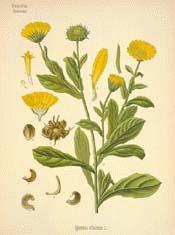Calendula (pot marigold) is considered as a super herb that has excellent healing and cosmetic properties. These properties are due to the potent active ingredients contained within its petals and leaves: essential oil (0.2%-).4%), saponins, flavonoids, vitamin C, calcium, carotenoids (precursors of vitamin A), chinones. All these substances make calendula a strong antioxidant. It also containes salicylic acid which has an analgesic effect, significant amounts of soothing mucilage and a bitter principle, calenduline, that has anti-inflammatory properties.
The combination of the above active ingredients makes calendula one of the most popular herbs in skin care. Calendula is used to treat wounds and skin irritations, burns, and eczema. It promotes skin elasticity and is used in stretch marks' treatment.
Calendula infused oil
To make this healing infused oil you will need:
- dried calendula petals, finely chopped
- vegetable oil preferably olive, sunflower or almond oils
- sterilized jars with lid
- cheesecloth or muslin
- dark glass bottles for storing the infused oils.
The ratio to use is 1:4, that is 1 part of dried chopped herbs to 4 parts of vegetable oil.
Put the herb into the jar and cover it with the vegetable oil. Let the herbs steep for at least 3 weeks in a warm place shaking it from time to time. Warmth facilitates the active ingredients of the herbs to be released.
Strain the herbs using a fine cheesecloth or muslin and store it in dark glass bottles. Label them. Adding vitamin E at a rate of 0.2% protects our infused oil from oxidation.
Calendula infused oil is used in massage oils, salves, balms, in healing creams and ointments.


Comments
Post a Comment